Relationships of Fire Rate of Spread with Spectral and Geometric Features Derived from UAV-Based Photogrammetric Point Clouds
Abstract
:1. Introduction
2. Materials and Methods
2.1. Study Sites
2.2. Overview of the Methods
2.3. Plot Selection
2.4. Data Collection
2.5. Photogrammetric and Thermal Image Processing
2.6. Fire Variable Processing
2.7. Point Cloud Processing
2.8. Data Fusion and Regression
3. Results
3.1. Photogrammetric Point Cloud Processing
3.2. Grid Size Determination
3.3. Fire Rate of Spread Regression
3.4. Feature Importance and Performance of the Models
3.5. Result Summary
4. Discussion
4.1. RoS Spatial Correlation
4.2. Data Acquisition and Model Generation
- Plots size. The plots have a total area of 6339.35 m2 in Sycan and 641.18 m2 in Lubrecht. The lack of model training data (means of 112 samples from the Lubrecht plots vs. 2810 samples from the Sycan plots) reduces the capacity of the models. This fact was observed in the Sycan plots, where the combination of the data from the two plots with a 7 m grid obtained the best fit.
- Plot characteristics. The different characteristics of the study areas (grasslands in Sycan and open forest in Lubrecht) may have affected the correct modeling of the RoS. In Lubrecht, we found less fuel type variability within the plots, while in Sycan, we found higher variability. This higher variability is related to the different RoS velocities detected in the plots. At Sycan, mean velocities of 0.18 m·s−1 and peak velocities of 2.7 m·s−1 were reached, while in the Lubrecht plots, mean velocities of 0.01 m·s−1 and maximum velocities of 0.139 m·s−1 were obtained.
- Spatial and spectral resolution. The different scales of the data collection at Lubrecht (very fine scale), with a flight height of 10 m, and Sycan (fine scale), with a flight height of 180 (plot 1) and 120 m (plot 2), may have affected the results obtained. The higher spatial resolution of Lubrecht did not imply an improvement of the results, so a significant increase in the spatial resolution does not necessarily improve the RoS prediction models. On the other hand, the difference in spectral resolution between the captures with an RGB camera and a multispectral camera does not seem to have affected the results, since the spectral features with the greatest permutation importance can be obtained with both cameras (e.g., the NBRDI, which only needs information from the blue and red bands).
4.3. Importance of the Features
4.4. Model Comparison
4.5. Key Findings
5. Conclusions
Author Contributions
Funding
Institutional Review Board Statement
Informed Consent Statement
Data Availability Statement
Conflicts of Interest
References
- Botella-Martínez, M.A.; Fernández-Manso, A. Estudio de la Severidad Post-Incendio en la Comunidad Valenciana Comparando los Índices DNBR, RdNBR y RBR a Partir de Imágenes Landsat 8. Rev. Teledetección 2017, 49, 33–47. [Google Scholar] [CrossRef]
- Weise, D.R.; Wright, C.S. Wildland Fire Emissions, Carbon and Climate: Characterizing Wildland Fuels. For. Ecol. Manag. 2014, 317, 26–40. [Google Scholar] [CrossRef]
- Twidwell, D.; Allen, C.R.; Detweiler, C.; Higgins, J.; Laney, C.; Elbaum, S. Smokey Comes of Age: Unmanned Aerial Systems for Fire Management. Front. Ecol. Environ. 2016, 14, 333–339. [Google Scholar] [CrossRef]
- Blanchi, R.; Leonard, J.; Haynes, K.; Opie, K.; James, M.; de Oliveira, F.D. Environmental Circumstances Surrounding Bushfire Fatalities in Australia 1901–2011. Environ. Sci. Policy 2014, 37, 192–203. [Google Scholar] [CrossRef]
- Syphard, A.D.; Rustigian-Romsos, H.; Mann, M.; Conlisk, E.; Moritz, M.A.; Ackerly, D. The Relative Influence of Climate and Housing Development on Current and Projected Future Fire Patterns and Structure Loss across Three California Landscapes. Glob. Environ. Chang. 2019, 56, 41–55. [Google Scholar] [CrossRef]
- Salis, M.; Laconi, M.; Ager, A.A.; Alcasena, F.J.; Arca, B.; Lozano, O.; Fernandes de Oliveira, A.; Spano, D. Evaluating Alternative Fuel Treatment Strategies to Reduce Wildfire Losses in a Mediterranean Area. For. Ecol. Manag. 2016, 368, 207–221. [Google Scholar] [CrossRef]
- Fernandes, P.M.; Botelho, H.S. A Review of Prescribed Burning Effectiveness in Fire Hazard Reduction. Int. J. Wildland Fire 2003, 12, 117. [Google Scholar] [CrossRef]
- Indiana Department of Natural Resources Prescribed Burning. Available online: https://www.in.gov/dnr/fish-and-wildlife/files/HMFSPrescribedBurn.pdf (accessed on 3 July 2023).
- Moran, C.J.; Seielstad, C.A.; Cunningham, M.R.; Hoff, V.; Parsons, R.A.; Queen, L.; Sauerbrey, K.; Wallace, T. Deriving Fire Behavior Metrics from UAS Imagery. Fire 2019, 2, 36. [Google Scholar] [CrossRef]
- Cruz, M.G.; Gould, J.S.; Alexander, M.E.; Sullivan, A.L.; McCaw, W.L.; Matthews, S. Empirical-Based Models for Predicting Head-Fire Rate of Spread in Australian Fuel Types. Aust. For. 2015, 78, 118–158. [Google Scholar] [CrossRef]
- Faivre, N.R.; Jin, Y.; Goulden, M.L.; Randerson, J.T. Spatial Patterns and Controls on Burned Area for Two Contrasting Fire Regimes in Southern California. Ecosphere 2016, 7, e01210. [Google Scholar] [CrossRef]
- Rothermel, R.C. A Mathematical Model for Predicting Fire Spread in Wildland Fuels; Intermountain Forest & Range Experiment Station, Forest Service, US Department of Agriculture: Ogden, UT, USA, 1972.
- McArthur, A.G. Weather and Grassland Fire Behaviour; Leaflet (Forestry and Timber Bureau); no. 100; Forestry and Timber Bureau: Canberra, Australia, 1966. [Google Scholar]
- Maffei, C.; Menenti, M. Predicting Forest Fires Burned Area and Rate of Spread from Pre-Fire Multispectral Satellite Measurements. ISPRS J. Photogramm. Remote Sens. 2019, 158, 263–278. [Google Scholar] [CrossRef]
- Chuvieco, E.; Aguado, I.; Salas, J.; García, M.; Yebra, M.; Oliva, P. Satellite Remote Sensing Contributions to Wildland Fire Science and Management. Curr. For. Rep. 2020, 6, 81–96. [Google Scholar] [CrossRef]
- Bailon-Ruiz, R.; Lacroix, S. Wildfire Remote Sensing with UAVs: A Review from the Autonomy Point of View. In Proceedings of the 2020 International Conference on Unmanned Aircraft Systems (ICUAS), Athens, Greece, 1–4 September 2020; pp. 412–420. [Google Scholar]
- Bajocco, S.; Guglietta, D.; Ricotta, C. Modelling Fire Occurrence at Regional Scale: Does Vegetation Phenology Matter? Eur. J. Remote Sens. 2015, 48, 763–775. [Google Scholar] [CrossRef]
- Hodges, J.L.; Lattimer, B.Y. Wildland Fire Spread Modeling Using Convolutional Neural Networks. Fire Technol. 2019, 55, 2115–2142. [Google Scholar] [CrossRef]
- Khanmohammadi, S.; Arashpour, M.; Golafshani, E.M.; Cruz, M.G.; Rajabifard, A.; Bai, Y. Prediction of Wildfire Rate of Spread in Grasslands Using Machine Learning Methods. Environ. Model. Softw. 2022, 156, 105507. [Google Scholar] [CrossRef]
- Yuan, C.; Zhang, Y.; Liu, Z. A Survey on Technologies for Automatic Forest Fire Monitoring, Detection, and Fighting Using Unmanned Aerial Vehicles and Remote Sensing Techniques. Can. J. For. Res. 2015, 45, 783–792. [Google Scholar] [CrossRef]
- Westoby, M.J.; Brasington, J.; Glasser, N.F.; Hambrey, M.J.; Reynolds, J.M. ‘Structure-from-Motion’ Photogrammetry: A Low-Cost, Effective Tool for Geoscience Applications. Geomorphology 2012, 179, 300–314. [Google Scholar] [CrossRef]
- Arévalo-Verjel, A.N.; Lerma, J.L.; Prieto, J.F.; Carbonell-Rivera, J.P.; Fernández, J. Estimation of the Block Adjustment Error in UAV Photogrammetric Flights in Flat Areas. Remote Sens. 2022, 14, 2877. [Google Scholar] [CrossRef]
- Carbonell-Rivera, J.P.; Torralba, J.; Estornell, J.; Ruiz, L.Á.; Crespo-Peremarch, P. Classification of Mediterranean Shrub Species from UAV Point Clouds. Remote Sens. 2022, 14, 199. [Google Scholar] [CrossRef]
- Hoffrén, R.; Lamelas, M.T.; de la Riva, J. UAV-Derived Photogrammetric Point Clouds and Multispectral Indices for Fuel Estimation in Mediterranean Forests. Remote Sens. Appl. 2023, 31, 100997. [Google Scholar] [CrossRef]
- Danson, F.M.; Sasse, F.; Schofield, L.A. Spectral and Spatial Information from a Novel Dual-Wavelength Full-Waveform Terrestrial Laser Scanner for Forest Ecology. Interface Focus. 2018, 8, 20170049. [Google Scholar] [CrossRef]
- Carbonell-Rivera, J.P.; Estornell, J.; Ruiz, L.Á.; Crespo-Peremarch, P.; Almonacid-Caballer, J.; Torralba, J. Class3Dp: A Supervised Classifier of Vegetation Species from Point Clouds. Environ. Model. Softw. 2024, 171, 105859. [Google Scholar] [CrossRef]
- Štroner, M.; Urban, R.; Línková, L. A New Method for UAV Lidar Precision Testing Used for the Evaluation of an Affordable DJI ZENMUSE L1 Scanner. Remote Sens. 2021, 13, 4811. [Google Scholar] [CrossRef]
- De Pondeca, M.S.F.V.; Manikin, G.S.; DiMego, G.; Benjamin, S.G.; Parrish, D.F.; Purser, R.J.; Wu, W.-S.; Horel, J.D.; Myrick, D.T.; Lin, Y.; et al. The Real-Time Mesoscale Analysis at NOAA’s National Centers for Environmental Prediction: Current Status and Development. Weather. Forecast. 2011, 26, 593–612. [Google Scholar] [CrossRef]
- MicaSense Incorporated RedEdge Camera Radiometric Calibration Model. Available online: https://support.micasense.com/hc/en-us/articles/115000351194-RedEdge-Camera-Radiometric-Calibration-Model (accessed on 5 August 2021).
- Dmitry Semyonov Algorithms Used in Photoscan. Available online: https://www.agisoft.com/forum/index.php?topic=89.0 (accessed on 28 June 2023).
- Lowe, D.G. Object Recognition from Local Scale-Invariant Features. In Proceedings of the Seventh IEEE International Conference on Computer Vision, Kerkyra, Greece, 20–27 September 1999; Volume 2, pp. 1150–1157. [Google Scholar]
- Ullman, S. The Interpretation of Structure from Motion. Proc. R. Soc. Lond. Ser. B Biol. Sci. 1979, 203, 405–426. [Google Scholar] [CrossRef]
- Canny, J. A Computational Approach to Edge Detection. IEEE Trans. Pattern Anal. Mach. Intell. 1986, PAMI-8, 679–698. [Google Scholar] [CrossRef]
- Lloyd, S. Least Squares Quantization in PCM. IEEE Trans. Inf. Theory 1982, 28, 129–137. [Google Scholar] [CrossRef]
- Kaufman, Y.J.; Tanre, D. Atmospherically Resistant Vegetation Index (ARVI) for EOS-MODIS. IEEE Trans. Geosci. Remote Sens. 1992, 30, 261–270. [Google Scholar] [CrossRef]
- Fraser, R.H.; van der Sluijs, J.; Hall, R.J. Calibrating Satellite-Based Indices of Burn Severity from UAV-Derived Metrics of a Burned Boreal Forest in NWT, Canada. Remote Sens. 2017, 9, 279. [Google Scholar] [CrossRef]
- Kataoka, T.; Kaneko, T.; Okamoto, H.; Hata, S. Crop Growth Estimation System Using Machine Vision. In Proceedings of the Proceedings 2003 IEEE/ASME International Conference on Advanced Intelligent Mechatronics (AIM 2003), Kobe, Japan, 20–24 July 2003; Volume 2, pp. b1079–b1083. [Google Scholar]
- Richardson, A.J.; Wiegand, C.L. Distinguishing Vegetation from Soil Background Information. Photogramm. Eng. Remote Sens. 1977, 43, 1541–1552. [Google Scholar]
- Huete, A.; Justice, C.; Van Leeuwen, W. MODIS Vegetation Index (MOD13); NASA Goddard Space Flight Center: Greenbelt, MD, USA, 1999; Volume 3.
- Dong, Y.X. Review of Otsu Segmentation Algorithm. Adv. Mat. Res. 2014, 989–994, 1959–1961. [Google Scholar] [CrossRef]
- Gitelson, A.A.; Kaufman, Y.J.; Merzlyak, M.N. Use of a Green Channel in Remote Sensing of Global Vegetation from EOS-MODIS. Remote Sens. Environ. 1996, 58, 289–298. [Google Scholar] [CrossRef]
- Ray, T.W.; Farr, T.G.; Blom, R.G.; Crippen, R.E. Monitoring Land Use and Degradation Using Satellite and Airborne Data. In Proceedings of the Summaries of the 4th Annual JPL Airborne Geoscience Workshop, Washington, DC, USA, 25–29 October 1993. [Google Scholar]
- Barbosa, B.D.S.; Ferraz, G.A.S.; Gonçalves, L.M.; Marin, D.B.; Maciel, D.T.; Ferraz, P.F.P.; Rossi, G. RGB Vegetation Indices Applied to Grass Monitoring: A Qualitative Analysis. Agron. Res. 2019, 17, 349–357. [Google Scholar] [CrossRef]
- Qi, J.; Chehbouni, A.; Huete, A.R.; Kerr, Y.H.; Sorooshian, S. A Modified Soil Adjusted Vegetation Index. Remote Sens. Environ. 1994, 48, 119–126. [Google Scholar] [CrossRef]
- Chen, J.M. Evaluation of Vegetation Indices and a Modified Simple Ratio for Boreal Applications. Can. J. Remote Sens. 1996, 22, 229–242. [Google Scholar] [CrossRef]
- Carbonell-Rivera, J.P.; Estornell, J.; Ruiz, L.A.; Torralba, J.; Crespo-Peremarch, P. Classification of UAV-Based Photogrammetric Point Clouds of Riverine Species Using Machine Learning Algorithms: A Case Study in the Palancia River, Spain. Int. Arch. Photogramm. Remote Sens. Spat. Inf. Sci. 2020, XLIII-B2-2020, 659–666. [Google Scholar] [CrossRef]
- Rouse, J.W.; Haas, R.H.; Schell, J.A.; Deering, D.W.; Harlan, J.C. Monitoring the Vernal Advancement and Retrogradation (Green Wave Effect) of Natural Vegetation; NASA/GSFC Type III Final Report; NASA/GSFC: Greenbelt, MD, USA, 1974; Volume 371.
- Shimada, S.; Matsumoto, J.; Sekiyama, A.; Aosier, B.; Yokohana, M. A New Spectral Index to Detect Poaceae Grass Abundance in Mongolian Grasslands. Adv. Space Res. 2012, 50, 1266–1273. [Google Scholar] [CrossRef]
- Hunt, E.R.; Cavigelli, M.; Daughtry, C.S.T.; Mcmurtrey, J.E.; Walthall, C.L. Evaluation of Digital Photography from Model Aircraft for Remote Sensing of Crop Biomass and Nitrogen Status. Precis. Agric. 2005, 6, 359–378. [Google Scholar] [CrossRef]
- Stricker, R.; Müller, S.; Gross, H.-M. Non-Contact Video-Based Pulse Rate Measurement on a Mobile Service Robot. In Proceedings of the 23rd IEEE International Symposium on Robot and Human Interactive Communication, Edinburgh, UK, 25–29 August 2014; pp. 1056–1062. [Google Scholar]
- Rondeaux, G.; Steven, M.; Baret, F. Optimization of Soil-Adjusted Vegetation Indices. Remote Sens. Environ. 1996, 55, 95–107. [Google Scholar] [CrossRef]
- Roujean, J.-L.; Breon, F.-M. Estimating PAR Absorbed by Vegetation from Bidirectional Reflectance Measurements. Remote Sens. Environ. 1995, 51, 375–384. [Google Scholar] [CrossRef]
- Gamon, J.A.; Surfus, J.S. Assessing Leaf Pigment Content and Activity with a Reflectometer. New Phytol. 1999, 143, 105–117. [Google Scholar] [CrossRef]
- Jordan, C.F. Derivation of Leaf-area Index from Quality of Light on the Forest Floor. Ecology 1969, 50, 663–666. [Google Scholar] [CrossRef]
- Huete, A.R. A Soil-Adjusted Vegetation Index (SAVI). Remote Sens. Environ. 1988, 25, 295–309. [Google Scholar] [CrossRef]
- Tucker, C.J. Red and Photographic Infrared Linear Combinations for Monitoring Vegetation. Remote Sens. Environ. 1979, 8, 127–150. [Google Scholar] [CrossRef]
- Gong, P.; Pu, R.; Biging, G.S.; Larrieu, M.R. Estimation of Forest Leaf Area Index Using Vegetation Indices Derived from Hyperion Hyperspectral Data. IEEE Trans. Geosci. Remote Sens. 2003, 41, 1355–1362. [Google Scholar] [CrossRef]
- Gitelson, A.A.; Kaufman, Y.J.; Stark, R.; Rundquist, D. Novel Algorithms for Remote Estimation of Vegetation Fraction. Remote Sens. Environ. 2002, 80, 76–87. [Google Scholar] [CrossRef]
- Costa, L.; Nunes, L.; Ampatzidis, Y. A New Visible Band Index (VNDVI) for Estimating NDVI Values on RGB Images Utilizing Genetic Algorithms. Comput. Electron. Agric. 2020, 172, 105334. [Google Scholar] [CrossRef]
- Chuvieco, E.; Cocero, D.; Riaño, D.; Martin, P.; Martínez-Vega, J.; de la Riva, J.; Pérez, F. Combining NDVI and Surface Temperature for the Estimation of Live Fuel Moisture Content in Forest Fire Danger Rating. Remote Sens. Environ. 2004, 92, 322–331. [Google Scholar] [CrossRef]
- Hiers, J.K.; O’Brien, J.J.; Mitchell, R.J.; Grego, J.M.; Loudermilk, E.L. The Wildland Fuel Cell Concept: An Approach to Characterize Fine-Scale Variation in Fuels and Fire in Frequently Burned Longleaf Pine Forests. Int. J. Wildland Fire 2009, 18, 315. [Google Scholar] [CrossRef]
- Balaguer, A.; Ruiz, L.A.; Hermosilla, T.; Recio, J.A. Definition of a Comprehensive Set of Texture Semivariogram Features and Their Evaluation for Object-Oriented Image Classification. Comput. Geosci. 2010, 36, 231–240. [Google Scholar] [CrossRef]
- Mckinney, W. Data Structures for Statistical Computing in Python. In Proceedings of the 9th Python in Science Conference (SciPy 2010), Austin, TX, USA, 28 June–3 July 2010. [Google Scholar]
- Jordahl, K.; Van den Bossche, J.; Fleischmann, M.; Wasserman, J.; McBride, J.; Gerard, J.; Tratner, J.; Perry, M.; Badaracco, A.G.; Farmer, C.; et al. Geopandas/Geopandas: V0.8.1. 2020. Available online: https://geopandas.org/en/stable/about/citing.html (accessed on 5 March 2024).
- Breiman, L. Random Forests. Mach. Learn. 2001, 45, 5–32. [Google Scholar] [CrossRef]
- Pedregosa, F.; Varoquaux, G.; Gramfort, A.; Michel, V.; Thirion, B.; Grisel, O.; Blondel, M.; Prettenhofer, P.; Weiss, R.; Dubourg, V. Scikit-Learn: Machine Learning in Python. J. Mach. Learn. Res. 2011, 12, 2825–2830. [Google Scholar]
- Geurts, P.; Ernst, D.; Wehenkel, L. Extremely Randomized Trees. Mach. Learn. 2006, 63, 3–42. [Google Scholar] [CrossRef]
- McArthur, A.G. Grassland Fire Danger Meter Mark V; Country Fire Authority: Melbourne, VIC, Australia, 1977.
- Cheney, N.P.; Gould, J.S.; Catchpole, W. Prediction of Fire Spread in Grasslands. Int. J. Wildland Fire 1998, 8, 1–13. [Google Scholar] [CrossRef]
- Anderson, W.R.; Cruz, M.G.; Fernandes, P.M.; McCaw, L.; Vega, J.A.; Bradstock, R.A.; Fogarty, L.; Gould, J.; McCarthy, G.; Marsden-Smedley, J.B.; et al. A Generic, Empirical-Based Model for Predicting Rate of Fire Spread in Shrublands. Int. J. Wildland Fire 2015, 24, 443. [Google Scholar] [CrossRef]
- Linn, R.R.; Winterkamp, J.L.; Furman, J.H.; Williams, B.; Hiers, J.K.; Jonko, A.; O’Brien, J.J.; Yedinak, K.M.; Goodrick, S. Modeling Low Intensity Fires: Lessons Learned from 2012 RxCADRE. Atmosphere 2021, 12, 139. [Google Scholar] [CrossRef]
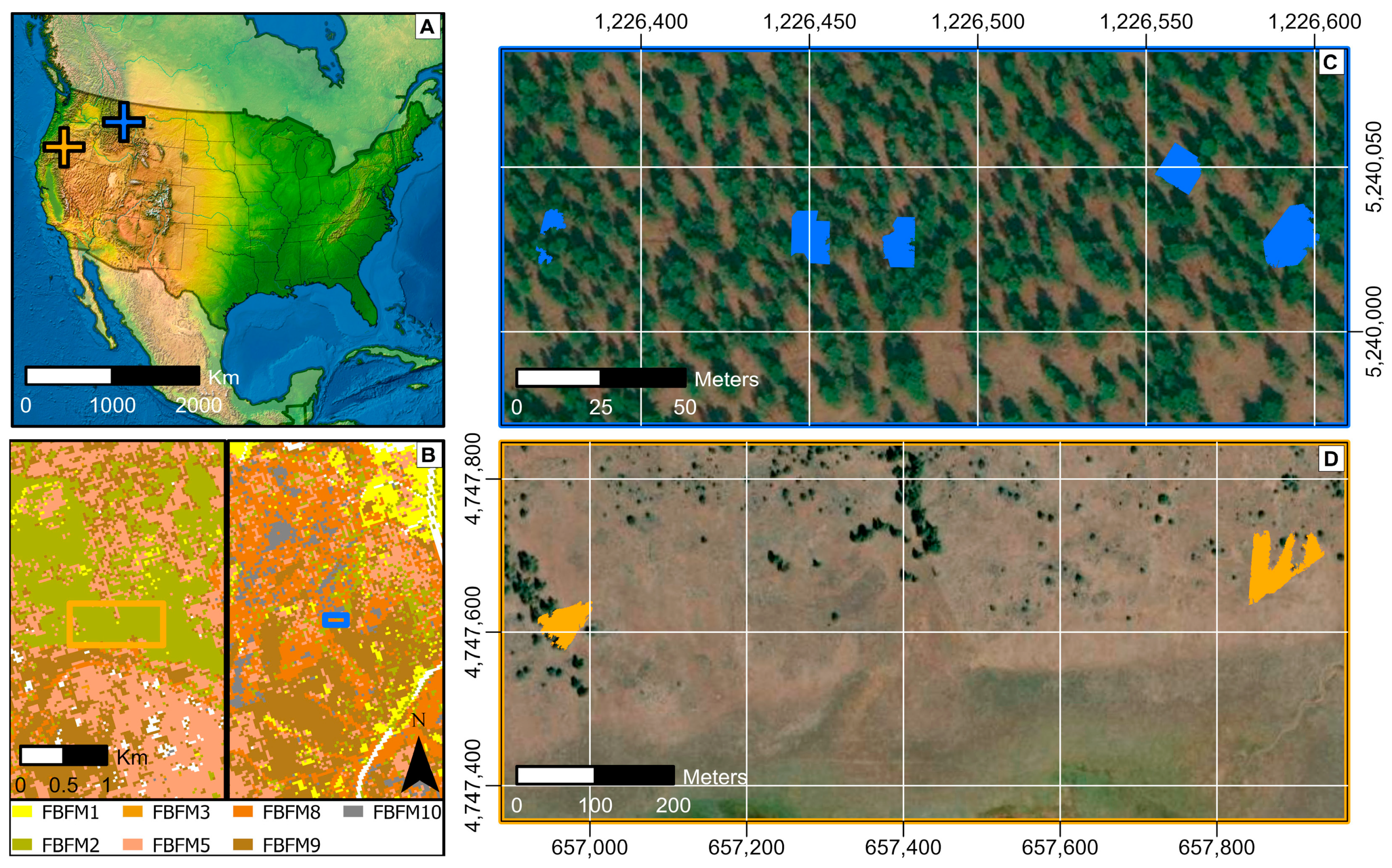
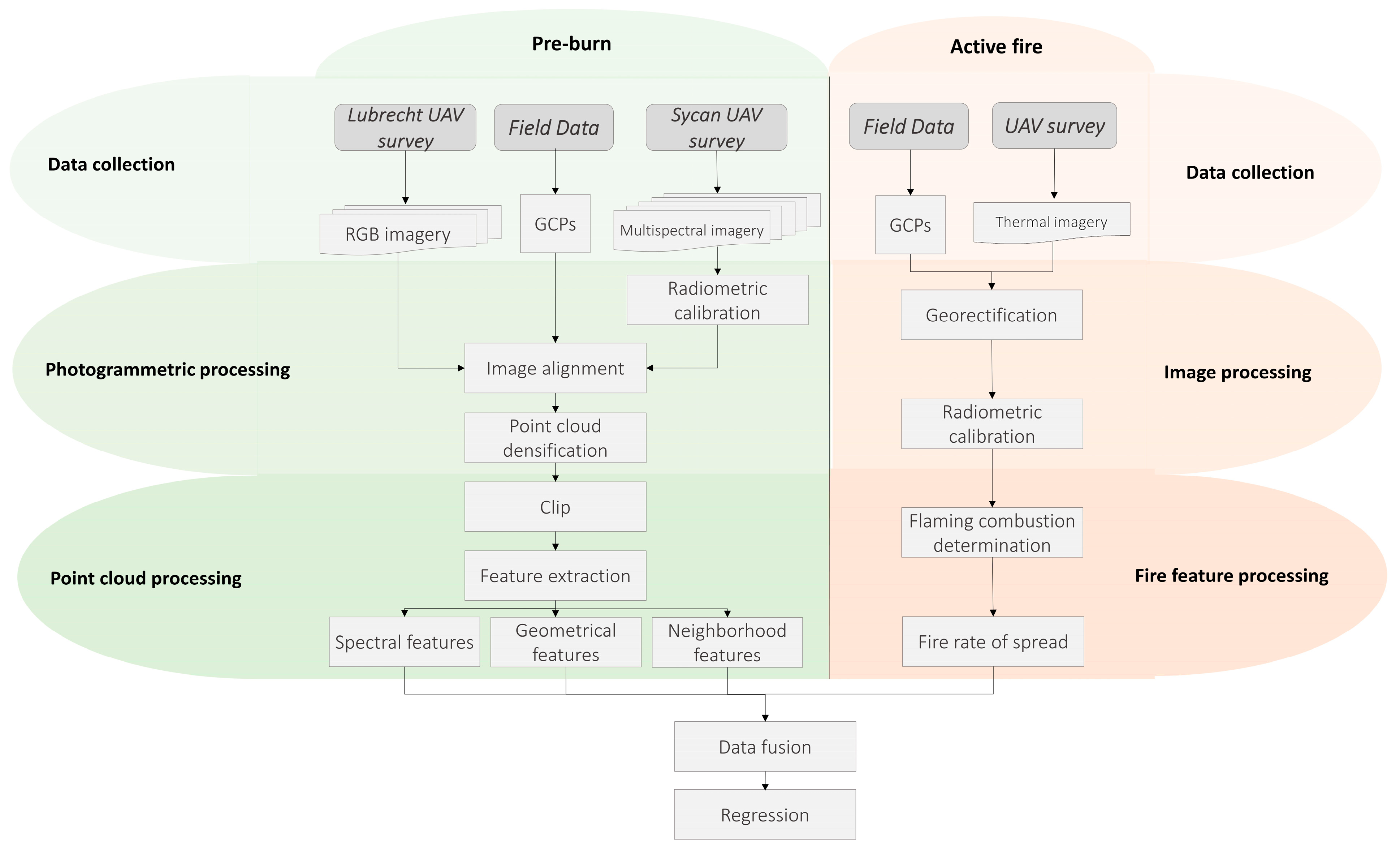
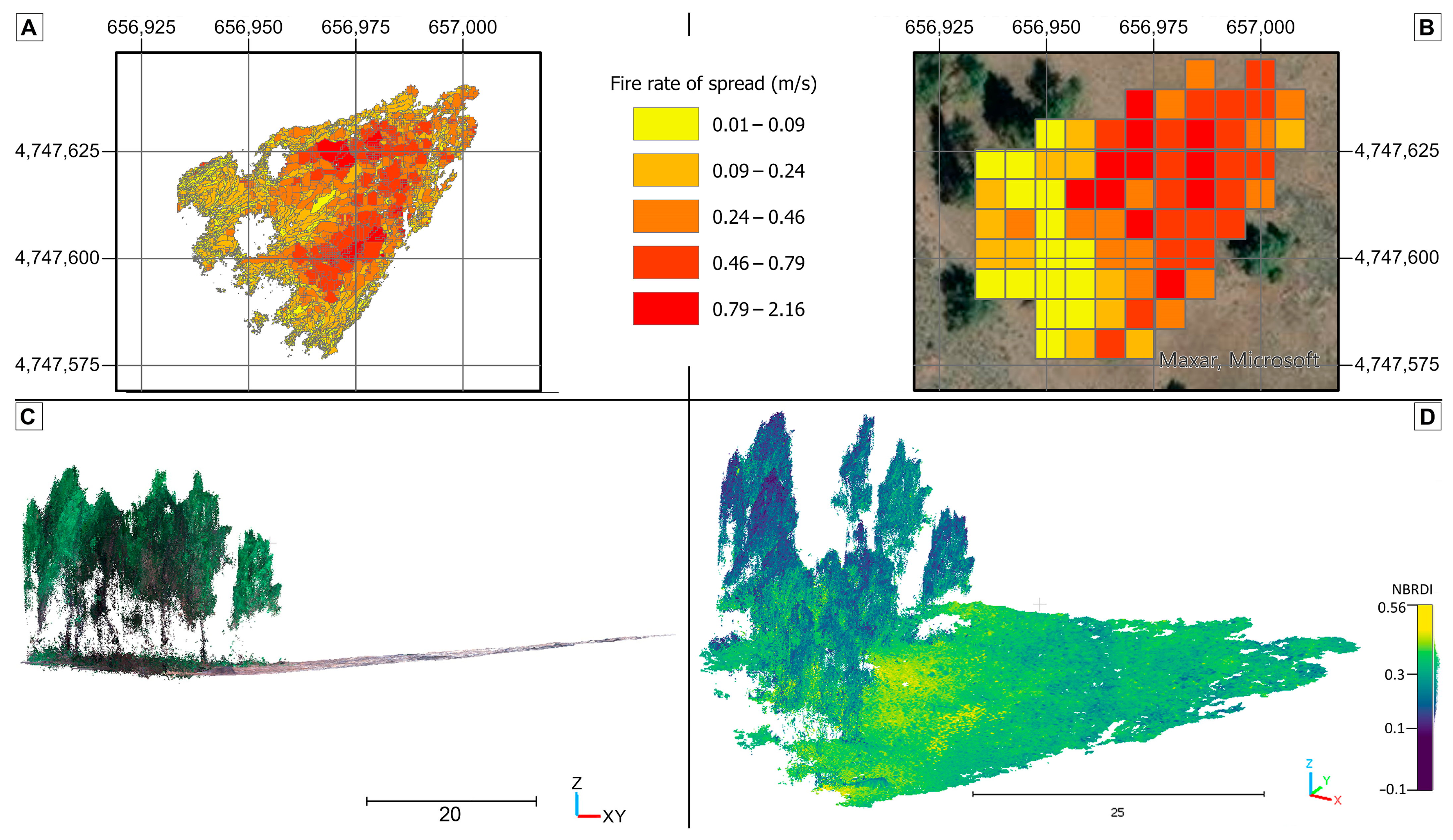

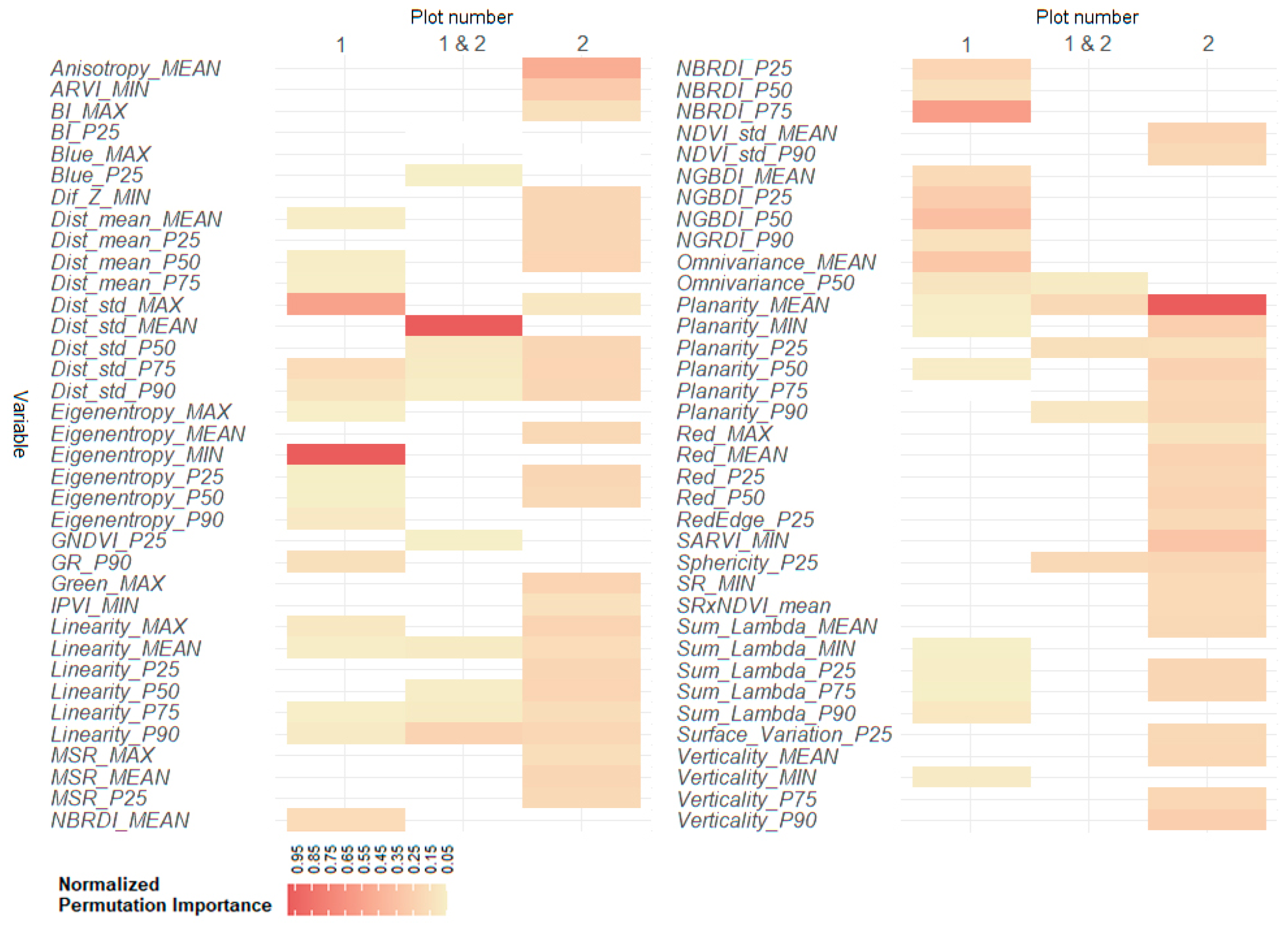
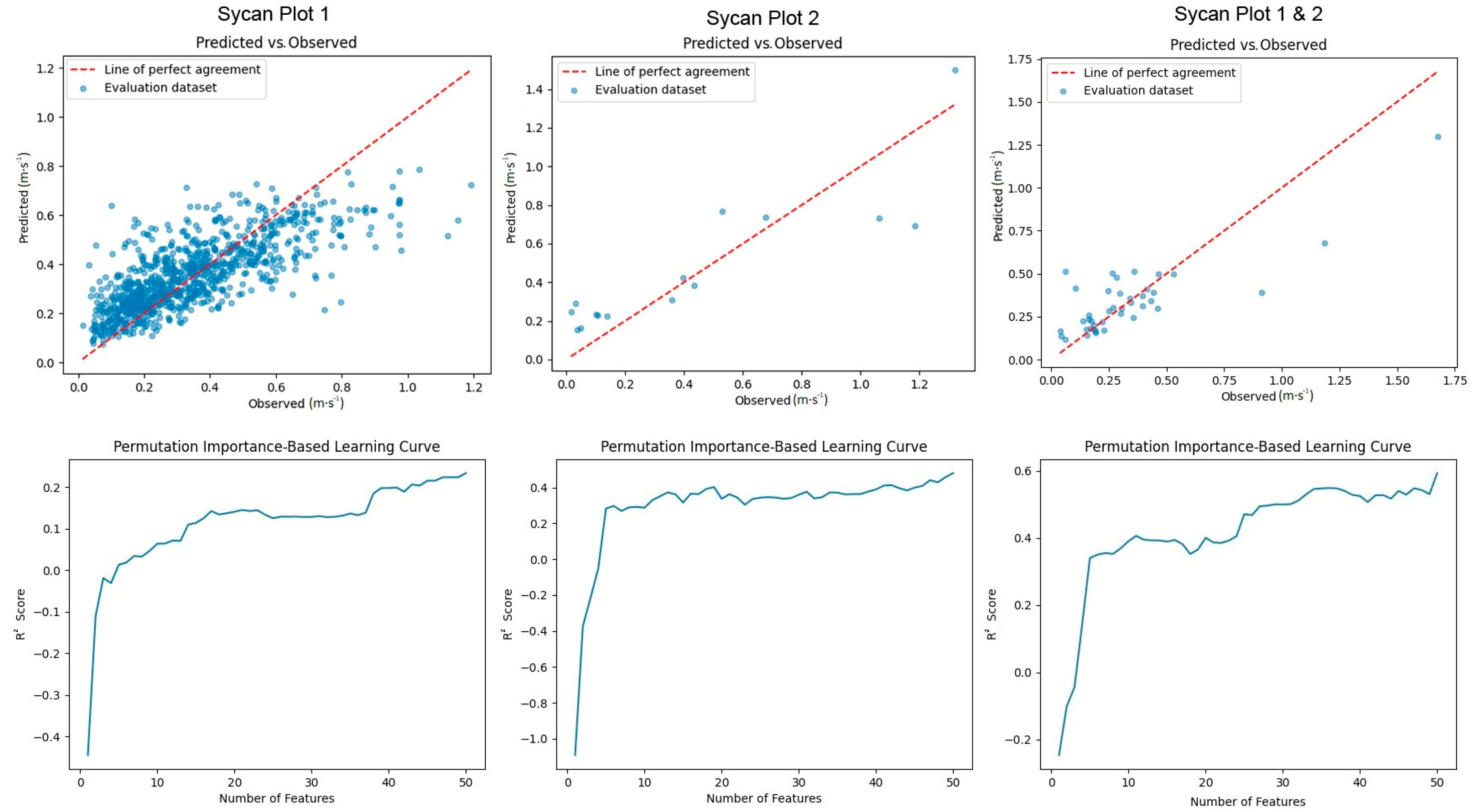
| Study Area | Plot Number | Plot Dimensions (m2) | Acquisition Date (UTC) | Slope (%) | Cloud Cover (%) | Ambient Temperature (°C) | Wind Speed (m·s−1) | Wind Direction (°) |
|---|---|---|---|---|---|---|---|---|
| Sycan | Plot 1 | 2269.16 | 23 October 2018 14:35–14:55 | 12.3 | 71.13 | −1.88 | 1.89 | 268.7 |
| Sycan | Plot 2 | 4070.18 | 23 October 2018 16:26–16:49 | 10.5 | 42.45 | 1.27 | 1.13 | 142.1 |
| Lubrecht | Plot 1 | 45.52 | 4 May 2017 15:13–15:25 | 53.2 | 10.55 | −3.91 | 0.87 | 93.3 |
| Lubrecht | Plot 2 | 149.21 | 4 May 2017 14:33–14:56 | 17.6 | 11.79 | −4.39 | 0.86 | 93.05 |
| Lubrecht | Plot 3 | 115.43 | 4 May 2017 14:04–14:29 | 14.05 | 13.03 | −4.87 | 0.86 | 92.8 |
| Lubrecht | Plot 4 | 122.41 | 4 May 2017 13:34–13:51 | 3.5 | 18.45 | −5.26 | 0.69 | 145.2 |
| Lubrecht | Plot 5 | 208.61 | 4 May 2017 13:12–13:27 | 17.6 | 23.87 | −5.65 | 0.53 | 197.6 |
| Spectrum | Name | Description | Equation | Reference |
|---|---|---|---|---|
| MS | ARVI | Atmospherically Resistant Vegetation Index | , | [35] |
| RGB and MS | BI | Brightness | [36] | |
| RGB | CIVE | Color Index of Vegetation | [37] | |
| MS | DVI | Differential Vegetation Index | [38] | |
| MS | EVI | Enhanced Vegetation Index | [39] | |
| RGB | GLI | Green Leaf Index | [40] | |
| MS | GNDVI | Green Normalized Difference Vegetation Index | [41] | |
| RGB and MS | GR | Green Divided by Red | [36] | |
| MS | IPVI | Infrared Percentage Vegetation Index | [42] | |
| RGB | MGVRI | Modified Green–Red Vegetation Index | [43] | |
| MS | MSAVI | Modified Soil-Adjusted Vegetation Index | [44] | |
| MS | MSR | Modified Simple Ratio Index | [45] | |
| RGB and MS | NBRDI | Normalized Blue–Red Difference Index | [46] | |
| MS | NDVI | Normalized Difference Vegetation Index | [47] | |
| RGB and MS | NGBDI | Normalized Green–Blue Difference Index | [48] | |
| RGB and MS | NGRDI | Normalized Green–Red Difference Index | [49] | |
| RGB | NormG | Normalized Greenness | [50] | |
| MS | OSAVI | Optimized Soil-Adjusted Vegetation Index | [51] | |
| MS | RDVI | Renormalized Difference Vegetation Index | [52] | |
| RGB and MS | RGRI | Red–Green Ratio Index | [53] | |
| MS | RVI | Ratio Vegetation Index | [54] | |
| RGB | SAVI | Soil-Adjusted Vegetation Index | [55] | |
| MS | SARVI | Soil and Atmospherically Resistant Vegetation Index | [55] | |
| MS | SR | Simple Ration Vegetation Index | [56] | |
| MS | SRxNDVI | Simple Ratio × Normalized Difference Vegetation Index | [57] | |
| RGB | VARI | Visual Atmospheric Resistance Index | [58] | |
| RGB | vNDVI | Visible Normalized Difference Vegetation Index | [59] |
| Name | Description | Equation |
|---|---|---|
| Dist_mean | Mean distance of the point with its neighboring points | |
| Dist_std | Standard deviation of the point with its neighboring points | |
| Z_std | Standard deviation height of the point and its neighbors | |
| Dif_Z | Neighborhood maximum height minus neighborhood minimum height | |
| Sum_λ | Sum of eigenvalues | |
| Omnivariance | Three-dimensional distribution of the points in the neighborhood | |
| Eigenentropy | Shannon entropy of the normalized eigenvalues | |
| Anisotropy | Change in the neighborhood in different directions | |
| Planarity | Two-dimensionality of the neighborhood on the x and y axes | |
| Linearity | Neighborhood dimensionality on one axis | |
| Surface Variation | Surface roughness in all three dimensions | |
| Sphericity | Resemblance of the neighborhood to the shape of a sphere | |
| Verticality | Z component of the normal vector |
| Study Area | Plot Number | Flight Pattern | Camera | Flight Height (m) | Total Points | Density (points·m−2) | Points after Clip |
|---|---|---|---|---|---|---|---|
| Sycan | Plot 1 | Cross-grid | MS | 180 | 23,104,435 | 307.96 | 1,193,082 |
| Sycan | Plot 2 | Cross-grid | MS | 120 | 36,652,049 | 400.38 | 1,745,488 |
| Lubrecht | Plot 1 | Cross-grid | RGB | 10 | 351,691,433 | 556,473.79 | 68,509,611 |
| Lubrecht | Plot 2 | Cross-grid | RGB | 10 | 191,301,913 | 759,134.58 | 140,705,771 |
| Lubrecht | Plot 3 | Cross-grid | RGB | 10 | 213,785,391 | 712,617.97 | 120,964,486 |
| Lubrecht | Plot 4 | Cross-grid | RGB | 10 | 227,097,818 | 811,063.64 | 166,984,447 |
| Lubrecht | Plot 5 | Cross-grid | RGB | 10 | 230,123,724 | 846,043.10 | 213,593,584 |
| Study Area | Plot | RoS Range (m·s−1) | Grid Size (m) | Hyperparameters | R2 | MAE (m·s−1) | RMSE (m·s−1) | MAE% | RMSE% |
|---|---|---|---|---|---|---|---|---|---|
| Sycan | 1 | 0.01–2.70 | 1 | ‘max_variables’: ‘auto’, ‘n_estimators’: 500, ‘max_depth’: None | 0.23 | 0.139 | 0.186 | 5.17 | 6.91 |
| Sycan | 2 | 0.01–2.16 | 7 | ‘max_variables’: ‘auto’, ‘n_estimators’: 500, ‘max_depth’: None | 0.48 | 0.262 | 0.369 | 12.19 | 17.16 |
| Sycan | 1 & 2 | 0.01–2.70 | 7 | ‘max_variables’: ‘auto’, ‘n_estimators’: 200, ‘max_depth’: None | 0.56 | 0.162 | 0.257 | 6.02 | 9.55 |
| Lubrecht | 1 | 0.001–0.078 | 1 | ‘max_variables’: ‘auto’, ‘n_estimators’: 200, ‘max_depth’: None | 0.13 | 0.003 | 0.004 | 3.90 | 5.19 |
| Lubrecht | 2 | 0.001–0.079 | 1 | ‘max_variables’: ‘auto’, ‘n_estimators’: 200, ‘max_depth’: 10 | 0.06 | 0.004 | 0.005 | 5.13 | 6.41 |
| Lubrecht | 3 | 0.002–0.139 | 1 | ‘max_variables’: ‘auto’, ‘n_estimators’: 500, ‘max_depth’: 10 | 0.15 | 0.002 | 0.004 | 1.46 | 2.92 |
| Lubrecht | 4 | 0.001–0.090 | 1 | ‘max_variables’: ‘auto’, ‘n_estimators’: 200, ‘max_depth’: 10 | −0.23 | 0.003 | 0.004 | 3.37 | 4.49 |
| Lubrecht | 5 | 0.002–0.100 | 1 | ‘max_variables’: ‘auto’, ‘n_estimators’: 200, ‘max_depth’: None | −0.18 | 0.002 | 0.003 | 2.04 | 3.06 |
| Lubrecht | 1, 2, 3, 4 & 5 | 0.001–0.139 | 1 | ‘max_variables’: ‘auto’, ‘n_estimators’: 200, ‘max_depth’: 10 | 0.05 | 0.003 | 0.004 | 2.17 | 2.90 |
Disclaimer/Publisher’s Note: The statements, opinions and data contained in all publications are solely those of the individual author(s) and contributor(s) and not of MDPI and/or the editor(s). MDPI and/or the editor(s) disclaim responsibility for any injury to people or property resulting from any ideas, methods, instructions or products referred to in the content. |
© 2024 by the authors. Licensee MDPI, Basel, Switzerland. This article is an open access article distributed under the terms and conditions of the Creative Commons Attribution (CC BY) license (https://creativecommons.org/licenses/by/4.0/).
Share and Cite
Carbonell-Rivera, J.P.; Moran, C.J.; Seielstad, C.A.; Parsons, R.A.; Hoff, V.; Ruiz, L.Á.; Torralba, J.; Estornell, J. Relationships of Fire Rate of Spread with Spectral and Geometric Features Derived from UAV-Based Photogrammetric Point Clouds. Fire 2024, 7, 132. https://doi.org/10.3390/fire7040132
Carbonell-Rivera JP, Moran CJ, Seielstad CA, Parsons RA, Hoff V, Ruiz LÁ, Torralba J, Estornell J. Relationships of Fire Rate of Spread with Spectral and Geometric Features Derived from UAV-Based Photogrammetric Point Clouds. Fire. 2024; 7(4):132. https://doi.org/10.3390/fire7040132
Chicago/Turabian StyleCarbonell-Rivera, Juan Pedro, Christopher J. Moran, Carl A. Seielstad, Russell A. Parsons, Valentijn Hoff, Luis Á. Ruiz, Jesús Torralba, and Javier Estornell. 2024. "Relationships of Fire Rate of Spread with Spectral and Geometric Features Derived from UAV-Based Photogrammetric Point Clouds" Fire 7, no. 4: 132. https://doi.org/10.3390/fire7040132







